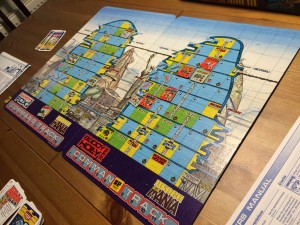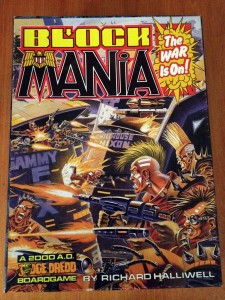Played: Block Mania
Posted by James (admin) on August 8th, 2014

Very early on and already both players have caused some damage to each other’s blocks. Towards the end of the game, blocks are full of collapse markers and fires.
I hadn’t played Block Mania for over 25 years and decided to give it another try this week. If you’re not aware of it, it was a game made by Games Workshop (back in the days when they did more than just their own licences) set in the world of Judge Dredd (from the 2000AD comics). The ultra-large high-rises (blocks) of Mega-City 1 sometimes start fighting with their neighbouring blocks for good or bad reasons (or, sometimes, for no reason at all).
When I played it when released in 1987, I found it was a great idea but just didn’t deliver the massive action it should have done. It seemed there were too few units on the board (because they were easily killed but not easily added). The reason for this is that each player would get 2-12 (2d6) action points (APs) to spend on their turn. This made the game very swingy, especially if one player rolled low and the other high.
Having done a lot of game designing since then, I now know how to address these things so, for this game, I decided to alter the AP system. I would have liked two identical decks of cards with different APs written on each card and players would draw a card from their own deck each turn – this would give relatively random APs per turn but each player would get the same overall as they’d both go through their identical decks. However, rather than make anything specific, APs were instead 1 dice + six (1d6+6) making them 7-12 per turn. This would give more APs so more action was possible. I suggested if a player rolled a 1 they should get +1 next turn but my opponent said not to bother – which they regretted later after rolling four 1’s in a row.
With more APs, the game was much more fun than I remember and the board always had various units on it. There’s still lots of randomness in the game because the new units, equipment, weapons, special action cards, etc. are all drawn randomly; plus, dice are also part of some other elements including attack rolls. Whilst I don’t like too much randomness in a game, the chaotic fun/story of the action plus the great Dredd setting (and maybe some nostalgia) meant that I didn’t mind this randomness. The game can tell a good story with some funny events and outcomes.
If you can do damage to the block itself then this can cause the space to collapse which, in turn, can trigger, more damage and more collapses – a bit like a crack spreading up a wall (which I guess is exactly what it is). The rules for how these spread, and for how fire spreads, were really good. Cause enough damage and the entire block comes crashing down (roll 5d6 and it falls down if you roll a number equal to or less than the number of collapse markers).
After a number of turns, the game enters the end game when the Judges arrive and start shutting things down. At this point players must play a Judge card each round which is what action the Judges take to stop the riot/war. As players play the cards, they usually try to play them so they affect their opponent most. Once it’s all quiet, players add up their defeat points and fewest defeat points wins. Defeat points are caused by graffiting your opponent’s block, looting their stores and bank, causing damage to their block, killing units, etc. Causing their block to collapse is 200 defeat points which almost certainly loses against a player’s whose did not collapse. So, whilst destroying units is fun, vandalising and damaging your opponent’s block is very important.
Overall, I was really pleased how much I enjoyed a game which I had always kept even though I thought it never quite delivered when I first bought it. With the more reliable amount of action points each turn, the chaos and the sweeping action deliver a lot of light-hearted fun which outweighs the randomness. I think there are some other rules changes which would tighten it up further, but those can be for the next play. I even have the expansion for 3-4 players too so I want to play with more players next time.
James.
[Played with 2 players]


